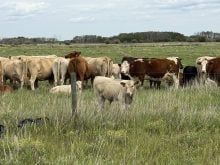This cattle market information is selected from the weekly report from Canfax, a division of the Canadian Cattlemen’s Association. More market information, analysis and statistics are available by becoming a Canfax subscriber by calling 403-275-5110 or at www.canfax.ca.
Packers have hammer
The seasonal shift of leverage from the packer to the cattle feeder has not materialized. Packers continue to have the upper hand on the market. Basis levels are weak, but prices tend to strengthen toward the end of the year, so many cattle feeders are adding additional weight to their cattle in hopes of higher prices.
Read Also

Canola used in only quarter of Canadian biofuel
Less than one-quarter of the biodiesel and renewable diesel used in Canada in 2024 was made from canola oil feedstock
Competition on the cash market was limited last week, with one packer buying most of the cattle. In some cases, packers limited the number of cattle purchased from each producer.
Dressed sales ranged from $304-$305 per hundredweight, $1-$4 per cwt. higher than the previous week. Cattle were booked for the weeks of Jan. 2 and 9 delivery.
Since the beginning of July, Canadian fed slaughter volumes are 49,000 head lower than last year. Based on U.S. Department of Agriculture weekly fed cattle import data, U.S. imports of Canadian fed cattle from July to now are 5,000 head larger than last year. Lower marketing rates for the second half of the year have underpinned the market.
Dressed sales in Ontario were reported from $306-$310 per cwt. delivered, steady to $4 per cwt. higher than the previous week.
Over the past 15 years, there are five that stand out as weak basis years: 2007, 2009, 2012, 2013, 2014. In all of these weak basis years, Alberta fed cash-to-futures basis levels strengthened from November to December.
In the United States, packers were buying for a short slaughter week, and prices set new annual highs. Dressed sales in Iowa and Nebraska ranged from US$240-$244 per cwt., steady to $1 per cwt. higher than the previous week. Sales in Texas and Kansas ranged from $150-$152 per cwt., while northern regions traded from $153-$155 per cwt., steady to $2 stronger.
U.S. steer carcass weights declined three pounds to average 925 lb. For the beginning of November, this is the second largest carcass weight on record.
According to the USDA, 2023 U.S. beef production is forecasted to be down 7.3 percent compared to 2022.
Mixed cow trade
Non-fed prices trended steady to softer last week on ample offerings and seasonally reduced trim and grind demand. Slaughter cows traded mixed with D2s steady, averaging $90.30 per cwt., and D3s slipping more than $1 per cwt. lower to average $77.17.
Dressed cow bids were generally steady from $175-$180 per cwt. delivered. Alberta D2 cows last week traded at almost a $10 per cwt. discount to U.S. utility cows. Butcher bull prices were the lowest since April, down $2.40 per cwt. from the previous week to $120.10 per cwt.
Western Canadian non-fed slaughter for the week ending Nov.12 was reported 26 percent larger than the previous week at 8,743 head.
Feeders generally steady
Alberta feeder prices trended steady to softer last week on ample offerings. Light calves less than 500 lb. saw the largest week-over-week declines on varied quality and reduced backgrounding interest. Benchmark 500-600 lb. calves traded steady to stronger, with prices comparable in Alberta and Saskatchewan.
Manitoba once again traded at a significant premium to the other prairie provinces, and 550 lb. weights were $12 per cwt. stronger than Ontario.
The price tone for steers heavier than 600 lb. was $1.25 per cwt. lower, while heifers ranged $3 per cwt. either side of steady. Large heifers heavier than 900 lb. were of replacement quality, and prices rallied almost $4 per cwt. stronger.
Alberta auction volumes were 32 percent larger than the previous week and were 57 percent larger than a year ago. Year-to-date auction volumes are down four percent, totalling 1,472,968 head.
Canadian feeder exports to the U.S. for the week ending Nov. 5 surged 61 percent larger than the previous week to 4,360 head and were 11 percent lower than the same week last year. Year-to-date feeder exports were 60 percent larger than a year ago, totalling 180,437 head.
Cutouts decline
In U.S. beef trade, cutouts began their autumn decline slightly earlier than historical averages suggest. Choice cutouts were down 2.3 percent to US$257.10 per cwt. and Select cutouts were down 2.1 percent to $231.74. Cutouts are still seven to nine percent higher than the five-year average for this time of year.
















